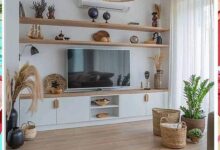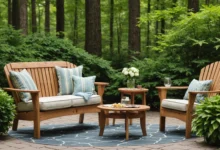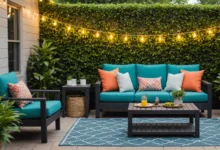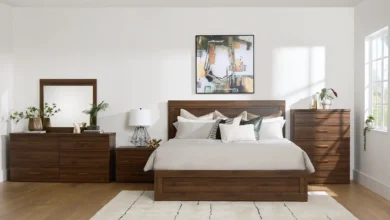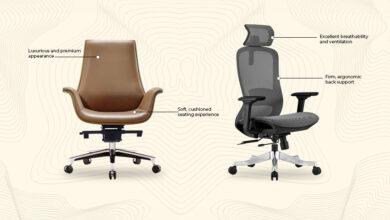Beyond the Basics: Modern Living Room Design Ideas for 2024
Transform your living room into a haven of comfort and style with these fresh and inviting modern design ideas. Forget stuffy, formal spaces – we’re diving into designs that prioritize relaxation, functionality, and a touch of personality, making your living room the perfect place to unwind and entertain.
Contents
- 1 Embracing Minimalist Elegance: Clean Lines and Open Spaces
- 2 Playful Pops of Color and Pattern: Injecting Personality
- 3 The Warmth of Natural Elements: Bringing Nature In
- 4 Modern Sophistication with Industrial Design Elements
- 5 The Art of Maximizing Space: Open-Concept Designs
- 6 Global Influences: Embracing a Multi-Cultural Aesthetic
- 7 Modern Chic with Sleek Lines and Geometric Patterns
- 8 Enhancing Comfort and Coziness with Soft Textiles
- 9 Illuminating the Space: Lighting as a Design Element
- 10 Bringing it All Together: Creating a Harmonious Design
- 11 Embracing the Minimalist Aesthetic: Clean Lines and Uncluttered Spaces
- 12 The Power of Layered Textures: Adding Depth and Dimension
- 13 The Art of Statement Lighting: Illuminating the Space
- 14 Incorporating Nature’s Elegance
- 15 The Joy of Color: Subtle Hues and Bold Accents
- 16 The Art of Furniture Selection: Functionality Meets Aesthetics
- 17 The Impact of Wall Decor: Adding Personality
- 18 The Magic of Rugs: Grounding and Defining Spaces
- 19 Accessorizing with Purpose: Finishing Touches That Make a Difference
- 20 Sustainable Design for a Modern Living Room
- 21 Embrace the Minimalist Aesthetic
- 22 Incorporating Nature into Your Space
- 23 Playing with Geometric Shapes
- 24 Lighting Strategies for a Modern Look
- 25 Playing with Colour Palettes
- 26 So, What’s Next for Your Living Room?
Embracing Minimalist Elegance: Clean Lines and Open Spaces
Minimalism isn’t just about stripping a room bare; it’s about creating a sense of calm and spaciousness through intentional design choices. Think clean lines, neutral palettes, and a focus on functionality. A minimalist living room often features a limited color scheme, typically sticking to whites, creams, grays, and subtle beiges. This allows the natural light to flow freely, maximizing the feeling of openness. Furniture is carefully selected, opting for pieces with simple forms and a focus on utility. Instead of cluttering the room with decorative objects, minimalist designs often rely on the architectural elements of the space itself – high ceilings, large windows, or even exposed beams – to provide visual interest. This aesthetic prioritizes the space’s inherent beauty rather than adding layers of embellishment. Textured rugs, strategically placed accent pieces, or a stunning statement artwork can elevate the minimalist design, but avoid overcrowding. Consider using natural materials like wood and stone to add warmth and depth. The key to success in minimalist living rooms is careful selection and a deep understanding of how each piece contributes to the overall ambiance. Remember, less is often more, and the careful consideration of every item adds to the sophisticated appeal of a minimalist space. Ultimately, minimalist design creates a modern atmosphere where serenity and functionality intertwine seamlessly.
Playful Pops of Color and Pattern: Injecting Personality
Don’t be afraid to let your personality shine through with vibrant pops of color and exciting patterns. A strategically placed patterned rug, a colorful sofa, or a bold artwork can instantly transform a living room from feeling neutral to full of personality. Think about incorporating different textures, from plush velvet to woven jute, to further add visual interest. The key is to balance the boldness of your choices with a neutral backdrop. This approach allows you to create a space that feels both welcoming and exciting. Experimenting with various color palettes can produce interesting results. For instance, a calming living room with pops of emerald green or fiery orange can invigorate the space without overwhelming it. If you prefer a more subdued approach, consider using pastel shades to add a touch of whimsy and playfulness. Pattern mixing is another great way to inject personality. A geometric patterned throw pillow paired with floral wallpaper can create an eclectic, yet balanced, look. Remember, the goal is to create a space that truly reflects your personal style while maintaining a sense of harmony. Think of it as an opportunity to express yourself without sacrificing the overall cohesiveness of the design. So embrace those vibrant hues and intricate patterns; they’re a fantastic way to make your living room feel uniquely you.
The Warmth of Natural Elements: Bringing Nature In
A living room bathed in natural light and infused with natural elements exudes warmth and a deep connection to the outdoors. Consider incorporating natural materials like wood, stone, and rattan. Wooden flooring, for instance, adds a touch of rustic charm while still remaining contemporary. Incorporating plants is another excellent strategy. Indoor greenery brings life and vibrancy to the space, promoting a sense of calm and inviting the outdoors in. Indoor plants add a calming element to your room, creating a serene atmosphere in any living space. They’re not only visually appealing but can also improve air quality. Opt for a variety of plants of varying heights and sizes to create depth and visual interest. Natural light is key, maximizing it through large windows or strategically placed mirrors can open up the room and amplify the feeling of connection to the natural world. Adding natural textiles, such as linen or wool throw blankets and curtains, brings a touch of organic elegance. The goal is to create a space that harmonizes with nature, making your living room feel both stylish and grounded. The subtle presence of nature in your living room brings a sense of harmony and enhances the overall beauty of your home.
Modern Sophistication with Industrial Design Elements
Industrial design brings a raw, edgy aesthetic to a living room, often creating a unique juxtaposition. Exposed brick walls, metal accents, and reclaimed wood pieces are characteristic of this style. Reclaimed wood can add a rustic yet modern touch, adding a layer of character and warmth. These elements contribute to a distinctive look, often with a cool, urban vibe. However, it’s important to achieve a balance. Industrial design elements, when paired with softer textures, can create a dynamic harmony that seamlessly blends raw appeal with comforting aesthetics. A plush velvet sofa or an inviting area rug can soften the hard lines and harsh materials inherent in this design style. The key lies in balancing the raw industrial materials with comfortable and inviting furniture pieces. This style works particularly well in open-concept living spaces where the flow of the room is emphasized. The balance between these seemingly opposing elements creates a captivating space that is both visually interesting and surprisingly inviting. It’s a style that exudes a sense of both strength and sophistication.
The Art of Maximizing Space: Open-Concept Designs
Open-concept living rooms are incredibly popular for their ability to create a sense of spaciousness and seamless flow between different areas of the home. Removing walls to connect the living room, kitchen, and dining areas creates a sense of grandness and openness. This design approach works beautifully in smaller homes or apartments, maximizing the feeling of space. Strategic use of furniture arrangements, like modular sofa units, is essential for defining distinct zones within the space without creating a feeling of clutter. This means paying attention to details like lighting arrangements and strategic placement to separate areas effectively. When designing for an open concept, carefully consider the arrangement of the furniture. The arrangement should maximize the available space while creating visual zones. Mirrors and strategically placed lighting can also help create an illusion of even more space. In open-concept designs, attention to detail is vital in defining spaces without visually obstructing the flow. It’s essential to create a cohesive design that flows seamlessly from one area to the next while maximizing the sense of spaciousness.
Global Influences: Embracing a Multi-Cultural Aesthetic
Infusing global influences into your living room design creates a unique and eclectic atmosphere, drawing inspiration from diverse cultures around the world. Consider incorporating elements from different regions through artwork, textiles, or furniture. A Moroccan-inspired rug or Japanese-style lighting fixture can add a touch of global flair. Each element should contribute to a sense of adventure and wanderlust. This could mean displaying a vibrant collection of decorative bowls from various countries or incorporating a traditional patterned rug from another continent. The key is to strike a balance between incorporating different cultural elements without overwhelming the room. You can achieve this by selecting complementary colors and patterns. Integrating these different global influences creates an atmosphere that speaks to the richness of the world while keeping a modern aesthetic. It’s a fascinating way to express a love of travel and different cultures.
Modern Chic with Sleek Lines and Geometric Patterns
Sleek lines and geometric patterns define a modern, sophisticated living room, embracing an atmosphere of clean simplicity. Geometric patterns create a visually stimulating environment while maintaining a strong sense of order. Think sharp lines, clean silhouettes, and a minimalist color palette. This often involves using metallic accents – chrome, brass, or nickel – to add a touch of modern glamour. The furniture plays a critical role in this style. Pieces with simple, streamlined shapes and a focus on clean lines exude sophistication. Materials such as glass, steel, and leather are often incorporated to add a touch of elegance. Consider a bold geometric rug or striking abstract artwork to add depth and visual interest. This design approach prioritizes visual impact. This style is not just visually striking but also functional, allowing for a streamlined flow and optimal use of space. It’s an ideal choice for those who appreciate clean lines and modern simplicity.
Enhancing Comfort and Coziness with Soft Textiles
Creating a cozy and inviting living room environment often involves a careful selection of soft textiles. Soft textures add comfort and a visual richness to the space. Think plush velvet armchairs, shaggy rugs, and cozy throws. Layer different textures, from fine linen to chunky knit blankets, to create depth and visual interest. The use of comfortable cushions, decorative throws, and upholstery are crucial to the creation of a welcoming and relaxed ambiance. Careful consideration of textures is essential in crafting a space that inspires tranquility. They evoke a sense of comfort and warmth, perfect for relaxing evenings or spending quality time with loved ones. Adding subtle textures like linen cushions and wool blankets contributes to the room’s tactile appeal, enhancing the overall comfort level. A soft lighting scheme complements the use of soft textiles, creating a warm and inviting atmosphere.
Illuminating the Space: Lighting as a Design Element
Lighting is a powerful design element that plays a crucial role in setting the mood and ambiance of a living room. Layers of lighting are crucial for creating a dynamic and well-lit space. Combine ambient lighting, task lighting, and accent lighting. Ambient lighting provides general illumination, while task lighting focuses on specific areas, like a reading nook or a desk. Accent lighting highlights specific features, like artwork or architectural details. Consider using a variety of light sources, from stylish pendant lights to strategically placed floor lamps and table lamps. This creates depth and visual interest. Lighting also affects the way the room is perceived, setting a particular mood that ranges from serene to vibrant. Using different light sources and adjusting their brightness can dramatically change the atmosphere, making a living room feel more welcoming or luxurious. Carefully chosen lighting solutions can transform a living room from functional to a well-designed and inspiring space.
Bringing it All Together: Creating a Harmonious Design
A well-designed living room should be more than just a collection of individual elements. The final step is to create harmony and balance among all of these design choices. Carefully consider how each element contributes to the overall feel and visual appeal. A cohesive color palette across all elements is fundamental to maintaining a sense of visual unity. The lighting scheme plays a role in enhancing the desired aesthetic. Consider the balance between soft and hard elements. A harmonious blend of textures and materials from flooring to furniture creates a layered look and evokes a feeling of interconnectedness. The integration of architectural features, if applicable, is a crucial aspect that enhances the overall appeal. Pay attention to the flow and natural movement of the space, and how these elements contribute to the desired ambience. Finally, remember that personal style and comfort are essential. A living room should not only look beautiful but also feel comfortable and welcoming, embodying the unique character of its inhabitants.
Embracing the Minimalist Aesthetic: Clean Lines and Uncluttered Spaces
Minimalism isn’t just about stripping things down; it’s about carefully curating a space that feels both serene and stylish. In a modern living room, this often translates to clean lines, neutral color palettes, and a focus on functionality. Think pared-down furniture pieces with sculpted forms, sleek surfaces reflecting light, and a harmonious balance between empty space and carefully placed accents. A minimalist living room isn’t stark; it’s sophisticated. It’s about letting the inherent beauty of the materials shine through, creating a tranquil and inviting atmosphere. The key is to avoid clutter, allowing the eye to rest on the carefully chosen elements. Consider using a neutral color palette like greys, creams, whites, and beige for your walls and furniture, which can create a backdrop for more vibrant accents. Incorporate natural materials like wood and stone for warmth and texture. This approach encourages a sense of spaciousness, making the room feel more open and airy. A minimalist approach isn’t about sacrificing comfort; instead, it’s about finding comfort in simplicity. A well-chosen rug, plush cushions, and strategically placed lighting can all contribute to a cozy atmosphere without overwhelming the space. Remember, less is often more in a minimalist living room, leading to a space that’s both aesthetically pleasing and remarkably functional. By emphasizing clean lines and purposeful design, you can create a minimalist living room that feels both modern and timeless.
The Power of Layered Textures: Adding Depth and Dimension
Creating visual interest in a modern living room goes beyond just color. Think about incorporating a variety of textures to add depth and dimension to your space. Imagine the soft, luxurious feel of a plush velvet sofa juxtaposed with the cool, smooth surface of a glass coffee table, or the rustic warmth of a wooden floor contrasting with the sleek metal accents of a modern chandelier. This interplay of textures evokes a sense of richness and complexity, making the space feel more inviting and personalized. Natural elements like woven baskets, sheepskin rugs, and linen throws offer a tactile element that immediately elevates the room’s appeal. You could also use textured fabrics in your upholstery, curtains, or throw pillows. Think about the way different textures interact with light, how they catch and reflect the rays. This play of light and shadow creates a more dynamic and visually interesting environment. Don’t be afraid to mix and match different textures. The key is to achieve a balanced and harmonious effect, avoiding overwhelming the space with too many contrasting elements. Ultimately, the goal is to create a room that feels lived-in and inviting, not sterile and impersonal, while still embracing the modern aesthetic. Explore various options for textures; wool, silk, cotton, linen, or even metallic finishes can all add a unique touch to your space.
The Art of Statement Lighting: Illuminating the Space
Lighting plays a crucial role in shaping the mood and atmosphere of any room, especially a modern living room. It’s not just about illuminating the space, it’s about creating a captivating ambiance. Consider incorporating a statement light fixture – perhaps a dramatic pendant light hanging above a dining area or a cluster of sleek, modern sconces flanking a fireplace. Don’t just think about the overall light; think about how various light sources can complement each other to enhance the room’s overall design. Consider using a mix of ambient lighting, task lighting, and accent lighting. Ambient lighting provides general illumination, while task lighting, like strategically placed lamps, focuses light on specific areas for reading or working. Accent lighting draws attention to particular features or artworks in the room, adding drama and highlighting their beauty. The right lighting can transform a living room from functional to truly captivating. A well-chosen chandelier can instantly uplift the aesthetic of a space, whilst strategically positioned floor lamps can offer a touch of warmth and coziness. The choice of light fixtures should complement the color scheme and furniture style of your living room. Experiment with different lighting styles, from warm, inviting incandescent bulbs to cool, contemporary LEDs, to create a versatile and welcoming ambiance.
Incorporating Nature’s Elegance
Bringing the outdoors in is a fantastic way to infuse your modern living room with a sense of tranquility and freshness. Incorporate natural elements like plants, wooden accents, and natural light to create a serene and aesthetically pleasing space. Plants of various sizes and types can instantly elevate the visual interest of any modern living room, adding vibrancy and life to the environment. Consider placing potted plants on shelves, tables, or even hanging them from the ceiling for a touch of greenery. The addition of natural materials like wood, stone, and bamboo can bring a sense of warmth and authenticity to the space. Natural light is also incredibly important. Maximize natural light by using sheer curtains or blinds that allow the sunlight to stream in, illuminating the room and creating a bright and airy atmosphere. Consider furniture pieces made from natural materials like wood, which can add an organic touch to the space and complement the overall design. By incorporating nature’s elements, you create a connection to the outside world, making the room feel more inviting and livable.
The Joy of Color: Subtle Hues and Bold Accents
A modern living room doesn’t have to be a monochrome masterpiece. A judicious use of color can elevate the room’s aesthetic and create a more personalized atmosphere. Play with subtle hues to create a sense of harmony and sophistication. Consider using a soft blue-gray or a warm cream as your base color to allow for the introduction of bolder accents. Adding a touch of vibrant color in smaller accents, such as throw pillows or artwork, can add a pop of personality to the space without overwhelming it. Accent walls can add a subtle touch of contrast, especially in a minimalist scheme. Focus on color coordination to create a harmonious effect. Don’t be afraid to mix and match complementary colors to create a visually engaging space. Color should be used strategically; it can energize, calm, or evoke different moods.
The Art of Furniture Selection: Functionality Meets Aesthetics
Modern furniture design is characterized by its sleek lines, clean silhouettes, and practical functionality. Choose pieces that serve a dual purpose; for example, a coffee table with storage underneath or a sofa with integrated seating for guests. Focus on pieces that blend seamlessly with your overall design aesthetic while maximizing space efficiency. When choosing furniture, consider its size in relation to the room’s dimensions. Avoid overly large pieces that can overwhelm the space, and prioritize pieces that complement the room’s scale. Look for furniture with refined details and a contemporary design language to ensure that the pieces complement your modern living room’s theme. Consider the materials used; durable materials such as leather or metal offer a modern feel, while natural materials like wood or rattan bring warmth and sophistication. The furniture choices you make significantly impact the space’s overall aesthetic and functionality.
The Impact of Wall Decor: Adding Personality
In a modern living room, the right wall decor can elevate the space from basic to truly captivating. A curated collection of art pieces, striking wall hangings, or an interesting wallpaper design can create a focal point and add a personal touch. Consider the size of the artwork in relation to the wall space, ensuring a balanced composition. Modern art often comes in bold colors, minimalist designs, or abstract forms, which can perfectly complement a modern aesthetic. The use of mirrors can also enhance the room’s visual appeal, reflecting natural light and creating an illusion of more space. Displaying personal photographs or family heirlooms can add a touch of warmth and personality to your living room, adding a significant value to your space. Consider the overall tone of the room when choosing wall decor; an eclectic collection of framed prints might suit a slightly more eclectic style, whereas a gallery wall with a selection of thoughtfully chosen pieces could work in a more minimalist space.
The Magic of Rugs: Grounding and Defining Spaces
Rugs play a significant role in defining spaces within a modern living room and offer a touch of texture and style. A well-chosen rug can anchor the room, creating a sense of warmth and grounding the furniture within the space. Consider the size of the rug in relation to your seating arrangement. A large rug can create a cozy seating area, while a smaller rug can define different zones within a larger open-plan layout. The material and color of the rug can significantly impact the overall feel of the room. Explore different materials, from luxurious wool to plush faux fur, to find the perfect rug that complements your style. By strategically placing a rug, you visually connect different elements of the room, creating a sense of unity and flow. A rug not only adds a touch of style but also protects your flooring and provides comfort.
Accessorizing with Purpose: Finishing Touches That Make a Difference
Accessorizing a modern living room goes beyond simply adding decorative items. It’s about carefully selecting pieces that complement the overall design and add personality without overwhelming the space. This involves thoughtfully incorporating elements that reflect your personal style and preferences. Think carefully about the placement of decorative objects; don’t overcrowd surfaces, and strive for a balanced presentation. Well-chosen lighting fixtures, decorative bowls, and sculptures can elevate the room’s aesthetic appeal. Plants can add a touch of nature, while strategically placed books can subtly highlight personality and style. The goal is to create a sense of balance, where every item has a purpose and contributes to the room’s overall ambience. Accents should not only look aesthetically pleasing but also resonate with your lifestyle.
Sustainable Design for a Modern Living Room
In today’s conscious world, sustainable design is increasingly important. Embrace eco-friendly materials and practices when designing your modern living room. Consider using reclaimed wood for furniture, or opting for sustainably sourced fabrics and textiles. Incorporate recycled or upcycled items into your decor to give existing items a new life. Look for brands committed to ethical and sustainable practices. By incorporating these practices, you reduce your environmental impact and promote a more responsible approach to design, contributing to a more eco-conscious and sustainable future.
Embrace the Minimalist Aesthetic
Minimalism, with its emphasis on clean lines, uncluttered spaces, and carefully chosen furnishings, is a popular choice for modern living rooms. This approach doesn’t mean sacrificing comfort or personality; instead, it focuses on maximizing the impact of each element. Think about the feeling of a well-curated gallery – a few key pieces are strategically placed against a backdrop of neutral tones, allowing their individual beauty to shine. In a minimalist living room, furniture plays a vital role. Sleek sofas with clean edges, low coffee tables, and simple side tables create a calm and uncluttered atmosphere. Consider materials like polished concrete, glass, or steel, which contribute to the contemporary feel without overwhelming the space. Layering different textures, like a plush rug or a chunky knit throw, can add depth and warmth without detracting from the overall minimalist aesthetic. Lighting is key here too. Strategic use of ambient lighting, task lighting, and accent lighting creates a sophisticated and inviting ambiance. Think about incorporating natural light as much as possible by keeping windows unobstructed and using sheer curtains or blinds for a soft diffusion. Remember, less is more. The careful selection of pieces and their thoughtful placement are crucial in conveying the essence of minimalist design. Don’t be afraid to experiment with different combinations of materials and colours, but always aim for a cohesive and balanced look. Minimalist designs are highly adaptable, perfect for both small and large living rooms, and offer a sense of calm and focus. Ultimately, it’s about prioritizing what truly matters and creating a space that reflects your personal style while maintaining a clean, uncluttered feel.
Incorporating Nature into Your Space
Bringing the outdoors in is a fantastic way to infuse your modern living room with a sense of tranquility and freshness. The introduction of natural elements adds a layer of warmth and visual interest. Consider incorporating natural wood tones in furniture, flooring, or accents. Large potted plants, or even a vertical garden, can add a touch of greenery. This isn’t just about putting plants in pots, it’s about creating a lived-in feel, a space that feels connected to the outside world. Think about the type of plants you choose; certain plants can actually improve air quality and create a soothing atmosphere. Furthermore, natural light plays a vital role in creating a connection to the outside. Maximize natural light by using sheer curtains or blinds that allow the sun’s rays to filter through. Open floor plans can enhance this effect further. Incorporating elements of nature can have a profound impact on your mood and well-being. The natural textures and colours create a calming effect, reducing stress and promoting relaxation. Consider using natural materials like bamboo or rattan for accents, or even incorporating a stone feature or a water feature to bring the soothing sounds and visual appeal of nature into the heart of your home. Remember, it’s about careful selection and thoughtful placement. An overabundance of greenery can sometimes overwhelm a space. Finding the right balance between natural elements and the overall design is essential.
Playing with Geometric Shapes
Geometric shapes offer an exciting opportunity to inject dynamism and visual interest into your modern living room design. They provide a striking contrast to traditional, more organic forms. Bold geometric patterns on cushions or rugs create a focal point, while angular furniture pieces add a modern twist. Consider incorporating shapes like squares, circles, triangles, and trapezoids to create a more dynamic atmosphere. This approach isn’t about overwhelming the space; it’s about strategic placement and careful consideration of proportion.
| Geometric Shapes and Their Effects |
|---|
| Squares and Rectangles: These shapes provide a sense of order and structure. They’re ideal for creating a defined area within the living room. |
| Circles and Ovals: Introduce a touch of softness and serenity, balancing the more angular shapes. |
| Triangles: Create a sense of drama and energy. They can be used as accents or as a focal point. |
Incorporating geometric shapes is about creating visual harmony and balance. A well-placed geometric rug or a set of patterned cushions can transform the entire room. Experiment with different sizes and colours to find the perfect balance for your space. Just remember, less can often be more. Overuse of geometric elements can lead to a chaotic feel; focus on creating focal points that draw the eye without being overwhelming.
Lighting Strategies for a Modern Look
Lighting is not merely about illumination in a modern living room; it’s about creating atmosphere and setting the mood. Strategic lighting choices can dramatically alter the perception of a space. Layer your lighting: Combine ambient lighting (like recessed lighting or a large chandelier), task lighting (like a table lamp or floor lamp), and accent lighting (like spotlights or wall sconces) for a well-rounded effect. Natural light is always a key element, ensuring plenty of windows and sheer curtains to maximize its benefits. Soft, warm lighting can create a cozy and inviting ambiance, while cooler lighting can make a space feel more modern and contemporary. Consider the colour temperature of your bulbs. Warm white lights (2700K-3000K) will provide a cozy feeling, while cool white lights (4000K-5000K) are better suited for a more vibrant and energetic space. Think about the mood you want to create in your living room. Are you looking for a space for relaxation and socializing, or do you want a room that’s ideal for work or study? Lighting should be integrated into the design, not just an afterthought. The right lighting can highlight architectural features, enhance the visual appeal of artwork, or create a specific ambiance for different activities.
Playing with Colour Palettes
Colour palettes play a crucial role in establishing the overall mood and aesthetic of your modern living room. A well-chosen colour scheme can dramatically impact the visual appeal of your space. Monochromatic palettes, using different shades of a single colour, create a sophisticated and calming atmosphere. Consider using varying shades of grey, blue, or green to create a sense of depth and interest. Neutral tones, like beige, cream, or taupe, are excellent choices for creating a sense of spaciousness and allowing other elements to stand out. Alternatively, bolder colour palettes, incorporating vibrant hues like deep blues, terracotta oranges, or emerald greens, can add a touch of personality and visual drama. Remember that the colours you choose should reflect your personal style and complement the furniture and accessories in your living room. You can introduce accent colours through decorative elements, such as cushions, throws, and artwork, to add a pop of vibrancy. Consider the overall effect you want to achieve in your living space. A calming, serene atmosphere might call for a cool colour palette, while a more energetic space might benefit from a bold and dynamic colour scheme. Understanding colour theory can help you create a harmonious and balanced living room environment. The key is to choose colours that you love and that work well together.
So, What’s Next for Your Living Room?
Well, there you have it – a few exciting modern living room design ideas to spark your creativity. Hopefully, you’ve found something inspiring to get those creative juices flowing. Thanks for joining us on this design journey. We’d love to see your living room transformations! Feel free to browse our other articles for more interior design inspiration, and be sure to stop back by soon for more fresh ideas.
